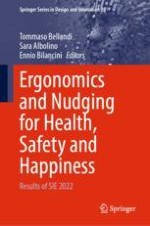2023 | OriginalPaper | Chapter
Themes of a Research Agenda for Sustainable Human Centred Design
Authors : Erminia Attaianese, Emilio Rossi
Published in: Ergonomics and Nudging for Health, Safety and Happiness
Publisher: Springer International Publishing
Activate our intelligent search to find suitable subject content or patents.
Select sections of text to find matching patents with Artificial Intelligence. powered by
Select sections of text to find additional relevant content using AI-assisted search. powered by
